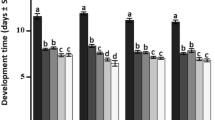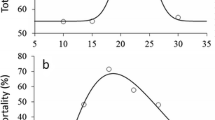Abstract
Egg parasitoids of the genus Trichogramma Westwood play an important role in the control of the velvetbean caterpillar Anticarisa gemmatalis Hübner in soybean crops in Southern Brazil. The effectiveness of Trichogramma species as biocontrol agents is dependent of several factors, but their adaptation to the climatic conditions of the region where they will be released is one of the most important. In this context, this study evaluated the effects of five constant temperatures ranging from 14 to 30°C on parasitism, age-specific survival, progeny production and longevity of Trichogramma pretiosum Riley, Trichogramma atopovirilia Oatman & Platner, Trichogramma acacioi Brun, Moraes & Soares, Trichogramma lasallei Pinto, and Trichogramma rojasi Nagaraja & Nagarkatti. We demonstrate that temperature differently affected the species of Trichogramma investigated when using eggs of the velvetbean caterpillar. We also demonstrate that T. pretiosum and T. atopovirilia are better adapted to a wide range of temperatures than the other species evaluated, and are therefore better suited as biocontrol agents for applied biological control programs of A. gemmatalis.


Similar content being viewed by others
References
Alencar JA, Haji FNP, Oliveira JC, Moreira AN (2000) Biologia de Trichogramma pretiosum Riley em ovos de Sitotroga cerealella (Oliver). Pesq Agropec Bras 35:1669–1674
Avanci MRF, Foerster LA, Cañete CL (2005) Natural parasitism in eggs of Anticarsia gemmatalis Hübner (Lepidoptera, Noctuidae) by Trichogramma spp. (Hymenoptera, Trichogrammatidae) in Brazil. Rev Bras Entomol 49:148–151
Bleicher E, Parra JRP (1990) Espécies de Trichogramma parasitoides de Alabama argillacea. I. Biologia de três populações. Pesq Agropec Bras 25:215–219
Bueno RCOF, Bueno AF, Parra JRP, Vieira SS, Oliveira LJ (2010) Biological characteristics and parasitism capacity of Trichogramma pretiosum Riley (Hymenoptera, Trichogrammatidae) on eggs of Spodoptera frugiperda (J.E. Smith) (Lepidoptera, Noctuidae). Rev Bras Entomol 54:322–327
Bueno RCOF, Parra JRP, Bueno AF (2012) Trichogramma pretiosum parasitism of Pseudoplusia includens and Anticarsia gemmatalis eggs at different temperatures. Biol Control 60:154–162
Corrigan JE, Laing JE (1994) Effects of the rearing host species and the host species attacked on performance by Trichogramma minutum Riley (Hymenoptera: Trichogrammatidae). Environ Entomol 23:755–760
DeBach P (1965) Weather and the success of parasites in population regulation. Can Entomol 97:848–863
Foerster LA, Avanci MRF (1999) Egg parasitoids of Anticarsia gemmatalis Hübner (Lepidoptera: Noctuidae) in soybeans. An Soc Entomol Bras 28:545–548
Foerster MR, Foerster LA (2009) Effects of temperature on the immature development and emergence of five species of Trichogramma. BioControl 54:445–450
Godfray HCJ (1994) Parasitoids. Behavioural and evolutionary ecology. Princeton University Press, Princeton, p 488
Hansen LS, Jensen KMV (2002) Effect of temperature on parasitism and host-feeding of Trichogramma turkestanica (Hymenoptera: Trichogrammatidae) on Ephestia kuehniella (Lepidoptera: Pyralidae). J Econ Entomol 95:50–56
Kaplan EL, Meier P (1958) Nonparametric estimation from incomplete observations. J Am Stat Assoc 53:457–481
Maceda A, Hohmann CL, Santos HR (2003) Temperature effects on Trichogramma pretiosum Riley and Trichogrammatoidea annulata De Santis. Braz Arch Biol Techn 46:27–32
Moscardi F (1999) Assessment of the application of baculoviruses for the control of Lepidoptera. Annu Rev Entomol 44:257–289
Pak GA, Oatman ER (1982) Comparative life table, behaviour and competition studies of Trichogramma brevicapillum and T. pretiosum. Entomol Exp Appl 32:68–79
Pak GA, Van Heiningen TG (1985) Behavioural variations among strains of Trichogramma spp.: adaptability to field-temperature conditions. Entomol Exp Appl 38:3–13
Parra JRP, Zucchi RA, Silveira-Neto S (1987) Biological control of pests through egg parasitoids of the genera Trichogramma and Trichogrammatoidea. Mem Inst Oswaldo Cruz 82:153–160
Pereira FF, Barros R, Pratissoli D, Pereira CLT, Vianna UR, Zanuncio JC (2007) Capacidade de parasitismo de Trichogramma exiguum Pinto & Platner, 1978 (Hymenoptera: Trichogrammatidae) em ovos de Plutella xylostella (L., 1758) (Lepidoptera: Plutellidae) em diferentes temperaturas. Cienc Rural 37:297–303
Pizzol J, Pintureau B, Khoualdia O, Desneux N (2010) Temperature-dependent differences in biological traits between two strains of Trichogramma cacoeciae (Hymenoptera: Trichogrammatidade). J Pest Sci 83:447–452
Polaszek A, Foerster LA (1997) Telenomus cyamophylax, n. sp. (Hymenoptera:Scelionidae) attacking eggs of the velvetbean caterpillar, Anticarsia gemmatalis Hübner (Lepidoptera:Noctuidae). An Soc Entomol Bras 26:177–181
Poorjavad N, Goldansaz SH, Hosseininaveh V, Nozari J, Dehghaniy H, Enkegaard A (2011) Fertility life table parameters of different strains of Trichogramma spp. collected from eggs of the carob moth Ectomyelois ceratoniae. Entomol Sci 14:245–253
Prasad RP, Roitberg BD, Henderson DE (2002) The effect of rearing temperature on parasitism by Trichogramma sibericum Sorkina at ambient temperatures. Biol Control 25:110–115
Pratissoli D, Bueno AF, Bueno RCOF, Zanúncio JC, Polanczyk RA (2009) Trichogramma acacioi (Hymenoptera, Trichogrammatidae) parasitism capacity at different temperatures and factitious hosts. Rev Bras Entomol 53:151–153
Ratte HT (1985) Temperature and insect development. In: Hoffmann KH (ed) Environmental physiology and biochemistry of insects. Springer, Berlin, pp 33–66
Reznik SY, Voinovich ND, Vaghina NP (2009) Effect of temperature on the reproduction and development of Trichogramma buesi (Hymenoptera: Trichogrammatidae). Eur J Entomol 106:535–544
Rounbehler MD, Ellington JJ (1973) Some biological effects of selected light regimes on Trichogramma semifumatum (Hym: Trichogrammatidae). Ann Entomol Soc Am 66:6–10
Romeis J, Babendreier D, Wäckers FL, Shanower TG (2005) Habitat and plant specificity of Trichogramma egg parasitoids—underlying mechanisms and implications. Basic Appl Ecol 6:215–236
Samara R, Monje JC, Zebitz CPW, Qubbaj T (2011) Comparative biology and life tables of Trichogramma aurosum on Cydia pomonella at constant temperatures. Phytoparasitica 39:109–119
Shipp JL, Wang K (1998) Evaluation of commercially produced Trichogramma spp. (Hymenoptera: Trichogrammatidae) for control of tomato pinworm, Keiferia lycopersicella (Lepidoptera: Gelechiidae), on greenhouse tomatoes. Can Entomol 130:721–731
Silva DM, Hoffmann-Campo CB, Bueno AF, Bueno RCOF, Oliveira MCN, Moscardi F (2012) Biological characteristics of Anticarsia gemmatalis (Lepidoptera: Noctuidae) for three consecutive generations under different temperatures: understanding the possible impact of global warming on a soybean pest. B Entomol Res 102:285–292
Sosa-Gómez DR (2004) Intraspecific variation and population structure of the velvetbean caterpillar, Anticarsia gemmatalis Hübner, 1818 (Insecta: Lepidoptera: Noctuidae). Genet Mol Biol 27:378–384
Statsoft Inc (2008) Statistica for windows. Statsoft Inc, Tulsa
Thomsom LJ, Hoffmann AA (2002) Laboratoy fecundity as predictor of field success in Trichogramma carverae (Hymenoptera: Trichogrammatidae). J Econ Entomol 95:912–917
van Lenteren JC, Roskam MM, Timmer T (1997) Commercial mass production and pricing of organisms for biological control of pests in Europe. Biol Control 10:143–149
West SA, Rivero A (2000) Using sex ratios to estimate what limits reproduction in parasitoids. Ecol Lett 3:294–299
Acknowledgments
The authors are grateful to Dr John Pinto (University of California, Riverside, USA), Dr Roberto A. Zucchi (Universidade de São Paulo—ESALQ/USP), Dr Ranyse BQ da Silva (Empresa Brasileira de Pesquisa Agropecuária—Embrapa) for the identification of the Trichogramma species. This research was performed with scholarships provided by the Brazilian National Research Council (CNPq) and Brazilian Federal Agency for Support and Evaluation of Graduate Education (CAPES).
Author information
Authors and Affiliations
Corresponding author
Additional information
Edited by Fernando L Cônsoli – ESALQ/USP
Rights and permissions
About this article
Cite this article
Foerster, M.R., Marchioro, C.A. & Foerster, L.A. Temperature-Dependent Parasitism, Survival, and Longevity of Five Species of Trichogramma Westwood (Hymenoptera: Trichogrammatidae) Associated with Anticarsia gemmatalis Hübner (Lepidoptera: Noctuidae). Neotrop Entomol 43, 176–182 (2014). https://doi.org/10.1007/s13744-013-0189-2
Received:
Accepted:
Published:
Issue Date:
DOI: https://doi.org/10.1007/s13744-013-0189-2




